Guest author Hugo Messer is the CEO of Ekipa and a global IT staffing expert.
When compared to office-dwelling counterparts, managing a remote team has always been a challenge. But at least these days, modern technology helps the cause more than ever. Today’s tools enable communication and work in ways previously thought unimaginable.
That doesn’t mean challenges don’t persist. Over the past 10 years, I have built many remote teams for our software customers, and I’ve established my own offices in India and Ukraine. As most entrepreneurs, I started without any experience at this. My generic management style was “laissez faire”—and I have learned the hard way that remote teams and a hands-off or laid-back approach are a tough combination.
The common barriers that managers come across lie in four areas: Different cultures, languages and time zones, plus geographical distance, can make for major obstacles in coordinating of far-flung teams. To overcome those issues, you need the proper tools and an understanding of the human behaviors (read: competencies) the team leader or manager must have.
This is the time-tested formula that has worked for me and my companies.
Crucial Tools To Help You Lead Remote Teams
Traditional teams are co-located, with everyone in the same building. Their physical location automatically places them in your company’s culture, and with so many opportunities to talk, it’s easy to convey your vision for a project or the company. That all changes when people are separated and scattered. You don’t drink coffee together regularly, and virtual bowling won’t get you there either.
To get your team on the same page, you literally need a page. To be specific, you need this page:
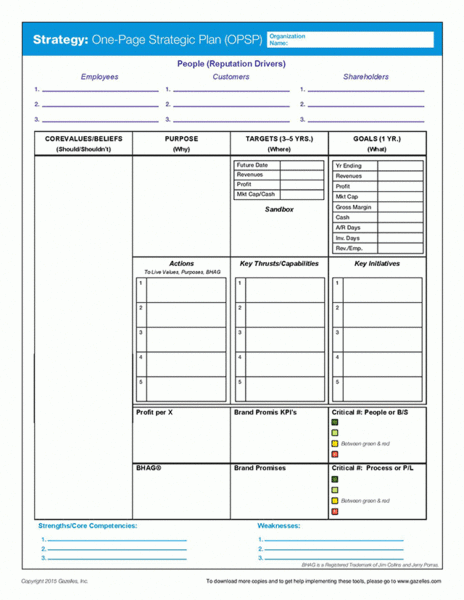
I discovered this one-page strategic plan from Gazelles six years ago, and found it to be an effective planning tool. It allowed us to visualize and share our long-term objectives, and translate targets into daily actions.
We fill out this plan every year at the end of December, with our full management team members—both remote and local—in a conference call. This planning session lets us to reflect on the fundamentals of our company: We recall examples of workers who lived our core values, evaluate our mission statement and stretch our thinking about how to achieve our big annual goal. The session also creates bonding within the team.
Also critical in our strategy: the quarterly review. Every three months, we take stock of our progress on our yearly plan, and look at what each of us achieved in the previous quarter. Then we plan the next quarter, with two to five top priorities. (We limit ourselves to 5, since doing a few things thoroughly yields better results than doing 20 things poorly at the same time.)
Each manager makes his or her own personal accountability plan for the quarter. To follow up, we hold an hour-long, weekly Skype call on Monday mornings.
Here’s a look at our weekly agenda.
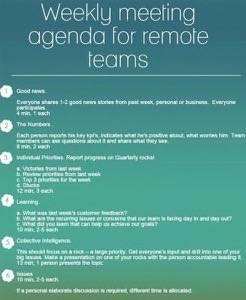
Weekly and quarterly tasks are organized accordingly;
- Create a Google document and share among members
- Each player creates a separate sheet to track the targets
- As you have seen, the KPI dashboard shows operational metrics
- Respectively rocks are indicated for the quarter
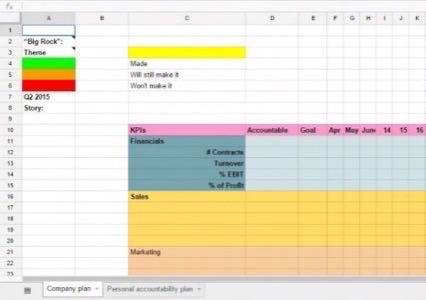
These periodic meetings help keep managers on track. For team members, we also hold daily Skype team calls of 5 to 10 minutes, with typically 3 to 5 people. (If the team is larger than that, we split them up into smaller increments.) The goal isn’t to inundate our business with meetings, but to nail down focal areas to make the rest of our time more productive. We hone in on three questions:
- What have you achieved yesterday?
- What will you work on today?
- Do you have any issues or blocks?
These inquiries are also the basis of scrums held by our software teams. The third question especially brings progress.
I notice that if we don’t ask this daily, people get stuck on their main weekly goal because they were waiting for someone else. If you don’t have talk time, they’ll tell you on Monday “I couldn’t do it because ABC wasn’t there.” If you talk daily, the team can immediately come up with a way to get ABC to deliver, so the employee can get the critical stuff done.
These strategies, plus the essential (and free) technologies at your disposal—including Skype, GoToMeeting, Sqwiggle, and Speek—meetings become smarter ways to personally engage with your remote team.
Implementing The Plan
A couple of weeks back, an audience member at one of my presentations asked me how I convinced my team to hold that many meetings. Personally, I really prefer “getting stuff done” over talking through every detail. But I can’t imagine managing my distributed team without these meetings.
Somehow these moments of reflection make the team more productive. People are accountable for achieving their plans and cannot hide. They also get more focus, since every goal is written down and clear.
My own plan is my roadmap all through the day; I use it to see what I need to focus on from moment to moment. A crucial piece of the puzzle was to make The Rockefeller Habits a mandatory read, as well as Verne Harnish’s book Mastering the Rockefeller Habits, to provide a deeper understanding of the one-page plan and the Rockefeller habits method.
To sum up, you can lead your remote team and get everyone on the same page by following these steps:
- Have everyone read The Rockefeller Habits.
- Download the one page strategic plan. (.PDF version from Gazelle here; my adapted version as a Google Sheet here)
- Schedule 1 to 2 days to fill the plan with your whole team. (If possible, get together in one location for this.)
- Have every team member create a personal quarterly plan.
- Create a meeting rhythm with quarterly, monthly, weekly and daily calls
- Stick to the rhythm!
How Adept Is Your Remote Team Manager?
You can have the best tools in the world, but if you have people who are incompetent, they will take you nowhere. Many books have been written on what it takes to be an effective manager. All of them likely apply, regardless of your team’s physical presence.
From my experience, four competencies make up a good remote team manager: empathy, organization, patience, and the ability to let go and trust the team.
Empathy: Empathy can be especially crucial for distributed employees based abroad. If they live in another culture, their behavior is heavily influenced by that culture, and that makes it tough for them to connect with everything going on locally. There’s also a risk that onshore team members place a higher value on their own work, or fault remote staff for “just not getting it, even when we explained everything up to the smallest details.”
This discord can drive people apart and lead to poor results, driving management to bring more of the work onshore. In the worst cases, the team eventually dissolves. A good manager will not only know how to empathize, but will ensure the attitude envelops the whole group.
Organization: Remote teamwork requires an extra dose of structure and management. Managers need to think through the collaboration process, the meeting rhythm, the “rules of engagement.” In order to leverage the process, the right tools need to be picked, so everyone knows what the goals are and what the steps are to achieve them. (Trello, Jira, Asana, Slack, Skype and Github can help a great deal with organization.)
In my company, we’ve developed a canvas that helps us think through the details for every collaboration we establish. The blocks from the canvas could help you determine what to look for while interviewing your new remote team manager.
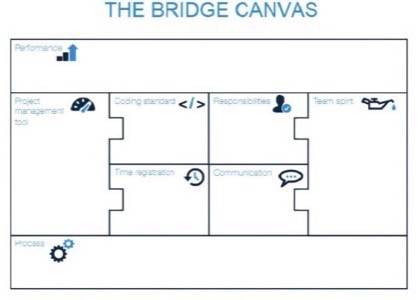
Patience: As famously quoted by Eknath Easwaran, a spiritual teacher and author of books on how to lead a successful life, being patient is like building a muscle—it can’t be achieved overnight.
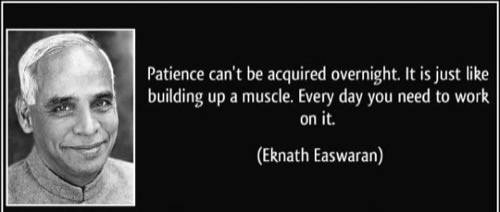
It takes time to make a remote team effective. Even the most empathetic people take time to understand subtle differences in people’s (culturally influenced) behavior. I have learned that, in general, the worst type of person to manage a remote team is often the entrepreneur (like me).
Entrepreneurs want speed, growth, change and are usually impatient. That can be both a virtue and a tough obstacle for their businesses. Teams need time to adjust. People make mistakes, miscommunicate, misinterpret. Individuals must have space to learn how others work, what to count on, how colleagues communicate. During this learning period, a remote team manager needs to patiently nurture the team.
Trust in the team: In effective teams, people doing the execution need to be accountable for results. In a remote team, this usually means that the remote team does most of the work. The manager is likely onshore and needs to trust the remote team 100%. That person needs to let go of any need to micro-manage or over-control what the team is doing.
The only thing that he or she should look at are output, measurement and accountability.
In scrum terms, the onshore manager is the product owner; the remote team including the scrum master is accountable for the output of each sprint. The manager defines clearly what output is necessary, and the team commits to delivering this output. While the work sprint is in progress, the team needs to be entrusted to do the work.
With the next remote team manager you plan to hire, do the following:
- Make a list of competencies you require for the role and include the ones in this article.
- Create questions for each block in the Bridge Canvas (look for answers on how the manager deals with each topic).
- Create questions to check for the competencies.
- Onboard and train your remote team manager on these competencies.
- Have the candidate read everything available on managing remote teams (starting with these ebooks).
Though managers are faced with ample blocks, research states that employees on remote workstations are more productive than traditional teams. So think of these tools and insights as a compass to guide managers and their people. With the right structure and resources in hand, a remote team manager who is empathic, organized, patient and who can “let go,” will reap the results.
Lead photo by Wesley Fryer










